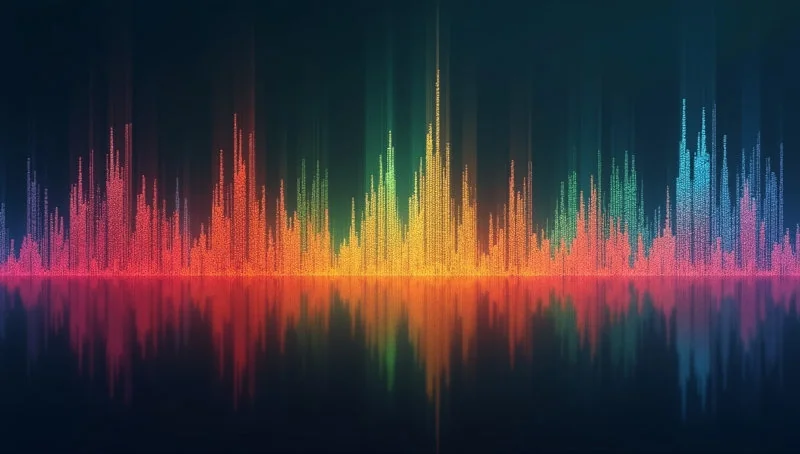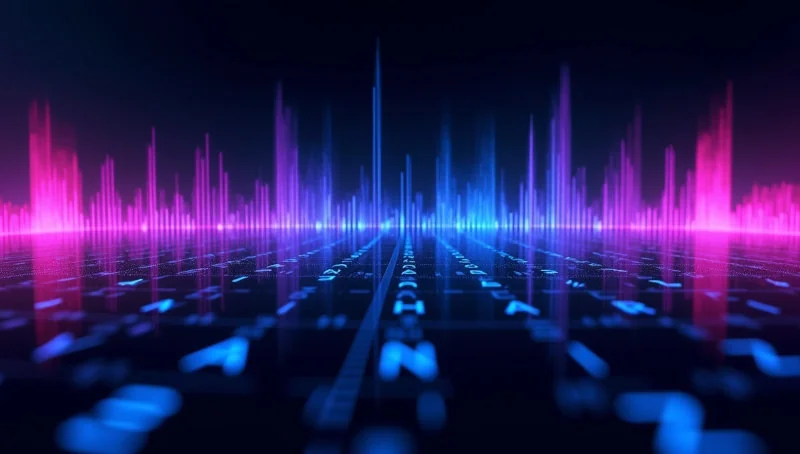The Ghost in the Machine: A Deep Dive into Audio Spectrograms
Published on

An image showing images in audio files
Sound, by its very nature, seems ephemeral. It’s a wave traveling through the air, a vibration we perceive for a moment before it vanishes. How could you possibly hide a static, visual image inside something so transient? Yet, for decades, electronic musicians, video game designers, and puzzle creators have been doing just that, embedding secret pictures and text into audio tracks, waiting for curious listeners to find them.
This technique, known as spectrogram steganography, is a beautiful and clever intersection of art, physics, and data security. To understand how it works, we have to stop listening to sound and start looking at it.
Table of Contents
- What is a Spectrogram?
- Drawing with Sound: How the Trick Works
- Famous Examples in the Wild
- The Tools of the Trade
- The Science Behind the Magic
- Applications and Implications
- Modern Developments
- A World of Hidden Messages
- Frequently Asked Questions
- References
What is a Spectrogram?
At its core, a spectrogram is a picture of sound. A spectrogram is a visual representation of the spectrum of frequencies of a signal as it varies with time. It’s a visual representation that plots three dimensions of audio onto a two-dimensional graph:
- Time: Represented on the horizontal axis (X-axis).
- Frequency (Pitch): Represented on the vertical axis (Y-axis), from low bass tones at the bottom to high treble tones at the top.
- Amplitude (Loudness): Represented by the color or brightness of a point on the graph. A louder sound at a specific frequency and time will appear as a brighter, more intense color.
Imagine a simple piano chord. On a spectrogram, you would see three distinct, bright horizontal lines appear at the exact moment the chord is played—one line for each note (frequency) in the chord. A complex piece of music creates a rich, textured, and often beautiful visual tapestry.

Drawing with Sound: How the Trick Works
The secret to hiding an image in a spectrogram lies in understanding that you can work backward. If you can analyze a sound to create an image, you can also generate a sound from an image.
The process is conceptually simple:
- Take an Image: Begin with a simple, high-contrast image, such as a line drawing, a logo, or text.
- Map Pixels to Sound: A special piece of software scans the image, row by row. For each pixel, it translates its position and brightness into a sound wave.
- The vertical position (Y-axis) of a pixel determines the frequency (pitch) of the sound. A pixel at the top of the image becomes a high-pitched tone, while a pixel at the bottom becomes a low-pitched tone.
- The horizontal position (X-axis) of a pixel determines the time at which that tone is played.
- The brightness of the pixel determines the amplitude (loudness) of the tone.
- Combine the Tones: The software generates thousands of these tiny, specific sine wave tones and layers them on top of each other, creating a complex audio file.
To the human ear, the resulting sound is often a cacophony of bizarre, electronic screeches, buzzes, and static. It sounds like a broken modem or an alien transmission. But to a spectrogram analyzer, which visualizes those exact frequencies at those same times, the original image magically reappears.
Famous Examples in the Wild

This isn’t just a theoretical concept; it has a rich history in music and gaming.
Aphex Twin’s “Windowlicker” (1999)
Perhaps the most famous example comes from the pioneering electronic musician Richard D. James, also known as Aphex Twin. While ‘Windowlicker’ was surprisingly climbing high on the UK charts, its B-side ’(∆Mᵢ⁻¹=−α ∑ Dᵢ[η][ ∑ Fjᵢ[η−1]+Fextᵢ [η⁻¹]])’ (or ‘Equation’ as it’s known to fans) hid a peculiar audio easter egg amid its aggressive experimentalism. The face was supposed to be viewable with a spectrograph program, situated at the very end of the track, starting from the 5:27 mark and lasting for about 10 seconds. Using the program ‘Metasynth’, AFX was able to embed an image that appeared as a distorted, demonic-looking face when viewed through spectral analysis software.
Nine Inch Nails and Industrial Music
Nine Inch Nails included a hidden image encoded as sound in the song “My Violent Heart” from the Year Zero album (2007), demonstrating that spectrogram steganography extended beyond experimental electronic music into industrial and alternative rock.
Video Games and ARGs
Video game developers love hiding secrets for their communities to discover. Portal was updated to feature parts of an eventually highly successful alternate reality game (or ARG) to promote its sequel, Portal 2. Codes may be hidden in text, images or audio files, and the WAV files also contained brief messages in Morse Code, as well as a phone number and a username/password combination. This technique is also a staple of Alternate Reality Games (ARGs), where players must solve a series of real-world and digital puzzles, and spectrograms often serve as a key method for delivering clues.
The Tools of the Trade

How can you find these hidden ghosts yourself? You need the right kind of “eyes.”
- Audio Editing Software: Professional and free audio editors almost always include a spectrogram view. Audacity, a fantastic and free open-source tool, is ideal for this purpose. You can import an audio file and switch the track’s view from “Waveform” to “Spectrogram”.
- Online Spectrogram Viewers: For a quick analysis without downloading any software, numerous websites allow you to upload an audio file and will instantly generate a spectrogram for you to view. This is often the fastest way to solve a puzzle.
- Specialized Software: Programs like MetaSynth, which was used by Aphex Twin, allow for both the creation and analysis of spectrogram-based audio art.
The Science Behind the Magic
The technical foundation of spectrogram steganography rests on well-established principles of digital signal processing. Digital audio steganography has emerged as a prominent source of data hiding across novel telecommunication technologies. Audio steganography is the process of hiding a message inside an audio cover file, and spectrum modification of the cover signal involves inserting the embedded data signal into regions of the cover signal spectrum where power of frequency components is low.
Modern research has expanded beyond simple frequency domain techniques. An effort has been made to focus on the transparency requirement of the considered methods used in the steganography process, ensuring that hidden messages remain imperceptible to casual listeners while maintaining audio quality.
Applications and Implications
Spectrogram steganography serves multiple purposes in our digital world:
Creative Expression: Artists use it as a form of digital art, creating audio pieces that reward careful analysis with hidden visual content.
Security Research: Novel robust and secure steganography techniques hide images into audio files aiming at increasing the carrier medium capacity, making it valuable for cybersecurity applications.
Educational Tools: Using sound for storing miscellaneous data isn’t something new, but this technology has seen better days, yet it remains an excellent way to teach concepts of signal processing and data hiding.
Communication: In scenarios where visual communication is monitored but audio is not, spectrogram steganography provides a covert channel for information transfer.
Modern Developments
Recent research has significantly advanced the field. Spread spectrum audio steganography combined with chaos theory provides optimized approaches for secure data transmission. Steganography models now seek to improve stego audio quality by implementing smoothing-based techniques and optimizing sample space through linear interpolation.
Additionally, combinations of encryption and steganography provide two levels of data protection in unified systems, creating more robust methods for protecting confidential information.
A World of Hidden Messages
From a simple colored word on a webpage to a complex pattern of network requests, steganography is all around us. Spectrogram steganography serves as a poignant reminder that data is data, whether it’s perceived as sound by our ears or as a glimpse into the hidden structure of a file, revealing the secrets that lie within.
By understanding these techniques, you are not just solving puzzles; you are learning the language of this hidden world. You are training your mind to look past the obvious and to ask the most important question a digital detective can ask: “What am I not seeing?”
Frequently Asked Questions
What is spectrogram steganography?
Spectrogram steganography is the technique of hiding visual data, such as images or text, within an audio file by encoding it into specific frequencies that appear as a visible pattern when viewed with a spectrogram analyzer.
How can I view a spectrogram to find hidden messages?
You can use audio editing software like Audacity, which has a spectrogram view, or online spectrogram viewers where you upload an audio file to generate a visual representation of its frequencies.
Why does spectrogram steganography sound like noise?
The audio often sounds like screeches or static because it consists of layered sine waves at specific frequencies and times to create a visual pattern in the spectrogram, which the human ear perceives as noise.
What are some real-world uses of spectrogram steganography?
It’s used in music for hidden easter eggs (e.g., Aphex Twin’s “Windowlicker”), in video games and ARGs for puzzle clues, and in cybersecurity for covert communication where audio channels are less monitored.
Is spectrogram steganography secure for hiding sensitive data?
While creative and subtle, it’s not highly secure on its own, as spectrogram analysis can reveal the hidden data. Combining it with encryption enhances security for sensitive communications.
References
Academic and Technical Sources
-
Cvejic, N., & Seppänen, T. (2012). Comparative study of digital audio steganography techniques. EURASIP Journal on Audio, Speech, and Music Processing, 2012, 25. https://asmp-eurasipjournals.springeropen.com/articles/10.1186/1687-4722-2012-25
-
Dhar, P. K., & Shimamura, T. (2020). A Novel Steganography Approach for Audio Files. SN Computer Science, 1(2), 80. https://link.springer.com/article/10.1007/s42979-020-0080-2
-
Djebbar, F., et al. (2021). Digital audio steganography: Systematic review, classification, and analysis of the current state of the art. Computer Science Review, 38, 100316. https://www.sciencedirect.com/science/article/abs/pii/S1574013720304160
-
Gomez-Hernandez, J., et al. (2024). Steganographic model to conceal the secret data in audio files utilizing a fourfold paradigm. Array, 21, 100320. https://www.sciencedirect.com/science/article/pii/S266644962400080X
-
Hasan, M. R., et al. (2022). A Systematic Review of Highly Transparent Steganographic Methods for the Digital Audio. In International Conference on Intelligent Systems Design and Applications (pp. 67-77). Springer. https://link.springer.com/chapter/10.1007/978-3-031-10539-5_5
-
Jain, M., et al. (2019). An Optimized Approach for Secure Data Transmission Using Spread Spectrum Audio Steganography, Chaos Theory, and Social Impact Theory Optimizer. Journal of Computer Networks and Communications, 2019, 5124364. https://www.hindawi.com/journals/jcnc/2019/5124364/
-
Korzh, O., et al. (2011). Audio Steganography Using Spectrum Manipulation. In Information and Communication Technologies in Education, Research, and Industrial Applications (pp. 261-271). Springer. https://link.springer.com/chapter/10.1007/978-3-642-20209-4_21
-
Taha, A., et al. (2024). A robust audio steganography technique based on image encryption using different chaotic maps. Scientific Reports, 14, 16836. https://www.nature.com/articles/s41598-024-70940-3
Historical and Cultural References
9.Arora, S. K. (2018). Audio Steganography: The art of hiding secrets within earshot (part 2 of 2). Medium. https://sumit-arora.medium.com/audio-steganography-the-art-of-hiding-secrets-within-earshot-part-2-of-2-c76b1be719b3
10.Bastwood (2012). The Aphex Face: Visualizing The Sound Spectrum From ‘#2’. Magnetic Magazine. https://magneticmag.com/2012/08/the-aphex-face-visualizing-the-sound-spectrum/
11.Far Out Magazine (2024). How Aphex Twin coded his face in his music. https://faroutmagazine.co.uk/how-aphex-twin-coded-his-face-into-music/
12.Mixmag (2025). Spectrogram art: A short history of musicians hiding visuals inside their tracks. https://mixmag.net/feature/spectrogram-art-music-aphex-twin
13.Solusipse (2021). Basic methods of Audio Steganography (spectrograms). Technical Blog. https://solusipse.net/blog/post/basic-methods-of-audio-steganography-spectrograms/
14.VICE (2024). Is the Image Hidden in Aphex Twin’s “Equation” the Best Easter Egg in Electronic Music? https://www.vice.com/en/article/nzm7mz/aphex-twin-easter-egg
Gaming and ARG References
15.Game Developer (2023). The Portal Two ARG: The Whole Story. https://www.gamedeveloper.com/business/the-portal-two-arg-the-whole-story
16.Half-Life Wiki (2024). Portal ARG. https://half-life.fandom.com/wiki/Portal_ARG
17.Portal Wiki (2025). Portal ARG. https://theportalwiki.com/wiki/Portal_ARG
18.The Escapist (2010). Crazy Valve ARG Teases… Portal 2? https://www.escapistmagazine.com/crazy-valve-arg-teases-portal-2-update/
Technical Resources
19.Audacity Team (2023). Audacity Manual: Spectrogram View. https://manual.audacityteam.org/man/spectrogram_view.html
20.Wikipedia (2025). Spectrogram. https://en.wikipedia.org/wiki/Spectrogram
21.Wikipedia (2025). Steganography. https://en.wikipedia.org/wiki/Steganography
Mathematical and Scientific Foundations
22.MathOverflow (2011). Where does Aphex Twin’s “windowlicker” equation come from? https://mathoverflow.net/questions/56489/where-does-aphex-twins-windowlicker-equation-come-from
23.Roads, C. (1996). The Computer Music Tutorial. MIT Press.
24.Smith, J. O. (2011). Spectral Audio Signal Processing. W3K Publishing. https://ccrma.stanford.edu/~jos/sasp/